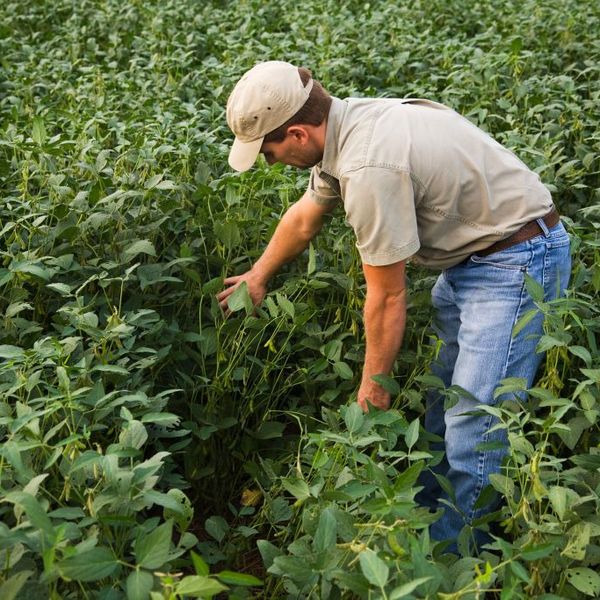
Melissa Roberts fixes dinner for her kids in Marks, Mississippi on January 13, 2022. Roberts relied on the federal child tax credit to help provide for her family after losing her job at the beginning of the pandemic. (Photo: Andrea Morales for The Washington Post via Getty Images)
USDA Report Shows How Covid Relief Helped Slash Food Insecurity in 2021
"If we give families more money (ideally with few restrictions and hoops to jump through), food insecurity goes down," said one sociologist.
New food insecurity data released by the U.S. Department of Agriculture on Wednesday provided the latest evidence that the enhanced child tax credit and other relief programs passed in the first two years of the Covid-19 pandemic significantly helped millions of Americans to support their families last year--and with much of the aid now ripped away, more households are again struggling to make ends meet.
The agency's annual report on food security showed that about 1 in 10 homes--or 13.5 million households--did not have enough food in 2021. Overall food insecurity remained the same from 2020 to 2021, and grew worse for women and older Americans living alone, but among families with children, there was a sharp drop in 2021.
"The prevalence of food insecurity declined from 2020 to 2021 for a few population subgroups, including households with children under age 18 and with children under age 6, married couples with children, and single mothers with children," reads the report.
Last year, 6.2% of households with children were unable to provide adequate and nutritious food for their children, down from 7.6% in 2020.
\u201cThe USDA's annual report on 2021 food insecurity -- the best data we have -- is out today. While overall food insecurity did not change between 2020 and 2021, food insecurity in households with children DECREASED. (It's lower than it has been in a long time). Why? (short \ud83e\uddf5)\u201d— Sarah Bowen (@Sarah Bowen) 1662558686
"The social safety net for families with children was better in 2021 than it has been" in the past, said Sarah Bowen, a sociologist at North Carolina State University, on social media Wednesday, pointing to the child tax credit (CTC), universal free lunches in many school districts, and Pandemic Electronic Benefit Transfer (P-EBT) cards that millions of people relied on last year.
"If we give families more money (ideally with few restrictions and hoops to jump through), food insecurity goes down," she added.
In the second half of 2021, the monthly CTC payments provided a total of up to $3,600 per child to nearly all middle- and low-income families in the U.S.--an "unprecedented" federal program, according to the Brookings Institution, which lifted 3.7 million children out of poverty.
Federal waivers included in the Families First Coronavirus Response Act of 2020 provided more flexibility for school districts to distribute meals to students and helped ensure an estimated 10 million children nationwide could have free lunches at school, and millions of families received extra assistance to buy food through the expansion of the Supplemental Nutrition Assistance Program (SNAP) during the pandemic.
But when right-wing lawmakers including Sen. Joe Manchin (D-W.Va.) refused to expand the CTC, the child poverty rate shot up by nearly 5% in just one month. Congress also failed to extend the school lunch waivers nationwide in June, and at least 16 states this year have declined to continue the pandemic-related SNAP benefits expansion--although the federal government permanently increased benefits in October 2021, saving households from seeing a larger decline in benefits.
While the USDA report contains "a lot of good news" regarding food insecurity in 2021, Diane Whitmore Schanzenbach of the Institute for Policy Research at Northwestern University told The Guardian, regular surveys by the U.S. Census Bureau this year are already showing "that food hardship has been steadily rising in families with children."
Related Content

Millions More Kids Going Hungry Since GOP, Manchin Killed Expanded Child Tax Credit
Overall, "food insecurity didn't change from 2019 to 2020 to 2021," said Leran Minc, assistant director of state policy for advocacy group Project Bread, "but perhaps it's because we did what was necessary in 2021--gave families more resources to buy basic needs including food."
In contrast, multiple relief programs have been slashed this year just as inflation and the war in Ukraine--which provides 30% of global wheat and maize exports--have pushed the price of groceries up by more than 13% in the U.S. since last July.
"Child poverty rates are growing while families are getting squeezed by rising inflation and gas prices," said the Friends Committee on National Legislation earlier this week. "Families need relief, and Congress can give it to them by making the expanded child tax credit available to all families, regardless of their income."
An Urgent Message From Our Co-Founder
Dear Common Dreams reader, The U.S. is on a fast track to authoritarianism like nothing I've ever seen. Meanwhile, corporate news outlets are utterly capitulating to Trump, twisting their coverage to avoid drawing his ire while lining up to stuff cash in his pockets. That's why I believe that Common Dreams is doing the best and most consequential reporting that we've ever done. Our small but mighty team is a progressive reporting powerhouse, covering the news every day that the corporate media never will. Our mission has always been simple: To inform. To inspire. And to ignite change for the common good. Now here's the key piece that I want all our readers to understand: None of this would be possible without your financial support. That's not just some fundraising cliche. It's the absolute and literal truth. We don't accept corporate advertising and never will. We don't have a paywall because we don't think people should be blocked from critical news based on their ability to pay. Everything we do is funded by the donations of readers like you. Will you donate now to help power the nonprofit, independent reporting of Common Dreams? Thank you for being a vital member of our community. Together, we can keep independent journalism alive when it’s needed most. - Craig Brown, Co-founder |
New food insecurity data released by the U.S. Department of Agriculture on Wednesday provided the latest evidence that the enhanced child tax credit and other relief programs passed in the first two years of the Covid-19 pandemic significantly helped millions of Americans to support their families last year--and with much of the aid now ripped away, more households are again struggling to make ends meet.
The agency's annual report on food security showed that about 1 in 10 homes--or 13.5 million households--did not have enough food in 2021. Overall food insecurity remained the same from 2020 to 2021, and grew worse for women and older Americans living alone, but among families with children, there was a sharp drop in 2021.
"The prevalence of food insecurity declined from 2020 to 2021 for a few population subgroups, including households with children under age 18 and with children under age 6, married couples with children, and single mothers with children," reads the report.
Last year, 6.2% of households with children were unable to provide adequate and nutritious food for their children, down from 7.6% in 2020.
\u201cThe USDA's annual report on 2021 food insecurity -- the best data we have -- is out today. While overall food insecurity did not change between 2020 and 2021, food insecurity in households with children DECREASED. (It's lower than it has been in a long time). Why? (short \ud83e\uddf5)\u201d— Sarah Bowen (@Sarah Bowen) 1662558686
"The social safety net for families with children was better in 2021 than it has been" in the past, said Sarah Bowen, a sociologist at North Carolina State University, on social media Wednesday, pointing to the child tax credit (CTC), universal free lunches in many school districts, and Pandemic Electronic Benefit Transfer (P-EBT) cards that millions of people relied on last year.
"If we give families more money (ideally with few restrictions and hoops to jump through), food insecurity goes down," she added.
In the second half of 2021, the monthly CTC payments provided a total of up to $3,600 per child to nearly all middle- and low-income families in the U.S.--an "unprecedented" federal program, according to the Brookings Institution, which lifted 3.7 million children out of poverty.
Federal waivers included in the Families First Coronavirus Response Act of 2020 provided more flexibility for school districts to distribute meals to students and helped ensure an estimated 10 million children nationwide could have free lunches at school, and millions of families received extra assistance to buy food through the expansion of the Supplemental Nutrition Assistance Program (SNAP) during the pandemic.
But when right-wing lawmakers including Sen. Joe Manchin (D-W.Va.) refused to expand the CTC, the child poverty rate shot up by nearly 5% in just one month. Congress also failed to extend the school lunch waivers nationwide in June, and at least 16 states this year have declined to continue the pandemic-related SNAP benefits expansion--although the federal government permanently increased benefits in October 2021, saving households from seeing a larger decline in benefits.
While the USDA report contains "a lot of good news" regarding food insecurity in 2021, Diane Whitmore Schanzenbach of the Institute for Policy Research at Northwestern University told The Guardian, regular surveys by the U.S. Census Bureau this year are already showing "that food hardship has been steadily rising in families with children."
Related Content

Millions More Kids Going Hungry Since GOP, Manchin Killed Expanded Child Tax Credit
Overall, "food insecurity didn't change from 2019 to 2020 to 2021," said Leran Minc, assistant director of state policy for advocacy group Project Bread, "but perhaps it's because we did what was necessary in 2021--gave families more resources to buy basic needs including food."
In contrast, multiple relief programs have been slashed this year just as inflation and the war in Ukraine--which provides 30% of global wheat and maize exports--have pushed the price of groceries up by more than 13% in the U.S. since last July.
"Child poverty rates are growing while families are getting squeezed by rising inflation and gas prices," said the Friends Committee on National Legislation earlier this week. "Families need relief, and Congress can give it to them by making the expanded child tax credit available to all families, regardless of their income."
New food insecurity data released by the U.S. Department of Agriculture on Wednesday provided the latest evidence that the enhanced child tax credit and other relief programs passed in the first two years of the Covid-19 pandemic significantly helped millions of Americans to support their families last year--and with much of the aid now ripped away, more households are again struggling to make ends meet.
The agency's annual report on food security showed that about 1 in 10 homes--or 13.5 million households--did not have enough food in 2021. Overall food insecurity remained the same from 2020 to 2021, and grew worse for women and older Americans living alone, but among families with children, there was a sharp drop in 2021.
"The prevalence of food insecurity declined from 2020 to 2021 for a few population subgroups, including households with children under age 18 and with children under age 6, married couples with children, and single mothers with children," reads the report.
Last year, 6.2% of households with children were unable to provide adequate and nutritious food for their children, down from 7.6% in 2020.
\u201cThe USDA's annual report on 2021 food insecurity -- the best data we have -- is out today. While overall food insecurity did not change between 2020 and 2021, food insecurity in households with children DECREASED. (It's lower than it has been in a long time). Why? (short \ud83e\uddf5)\u201d— Sarah Bowen (@Sarah Bowen) 1662558686
"The social safety net for families with children was better in 2021 than it has been" in the past, said Sarah Bowen, a sociologist at North Carolina State University, on social media Wednesday, pointing to the child tax credit (CTC), universal free lunches in many school districts, and Pandemic Electronic Benefit Transfer (P-EBT) cards that millions of people relied on last year.
"If we give families more money (ideally with few restrictions and hoops to jump through), food insecurity goes down," she added.
In the second half of 2021, the monthly CTC payments provided a total of up to $3,600 per child to nearly all middle- and low-income families in the U.S.--an "unprecedented" federal program, according to the Brookings Institution, which lifted 3.7 million children out of poverty.
Federal waivers included in the Families First Coronavirus Response Act of 2020 provided more flexibility for school districts to distribute meals to students and helped ensure an estimated 10 million children nationwide could have free lunches at school, and millions of families received extra assistance to buy food through the expansion of the Supplemental Nutrition Assistance Program (SNAP) during the pandemic.
But when right-wing lawmakers including Sen. Joe Manchin (D-W.Va.) refused to expand the CTC, the child poverty rate shot up by nearly 5% in just one month. Congress also failed to extend the school lunch waivers nationwide in June, and at least 16 states this year have declined to continue the pandemic-related SNAP benefits expansion--although the federal government permanently increased benefits in October 2021, saving households from seeing a larger decline in benefits.
While the USDA report contains "a lot of good news" regarding food insecurity in 2021, Diane Whitmore Schanzenbach of the Institute for Policy Research at Northwestern University told The Guardian, regular surveys by the U.S. Census Bureau this year are already showing "that food hardship has been steadily rising in families with children."
Related Content

Millions More Kids Going Hungry Since GOP, Manchin Killed Expanded Child Tax Credit
Overall, "food insecurity didn't change from 2019 to 2020 to 2021," said Leran Minc, assistant director of state policy for advocacy group Project Bread, "but perhaps it's because we did what was necessary in 2021--gave families more resources to buy basic needs including food."
In contrast, multiple relief programs have been slashed this year just as inflation and the war in Ukraine--which provides 30% of global wheat and maize exports--have pushed the price of groceries up by more than 13% in the U.S. since last July.
"Child poverty rates are growing while families are getting squeezed by rising inflation and gas prices," said the Friends Committee on National Legislation earlier this week. "Families need relief, and Congress can give it to them by making the expanded child tax credit available to all families, regardless of their income."

